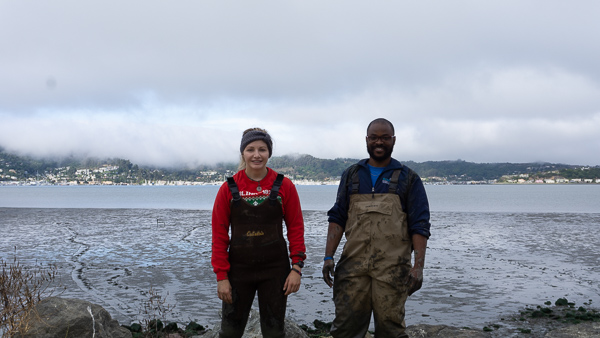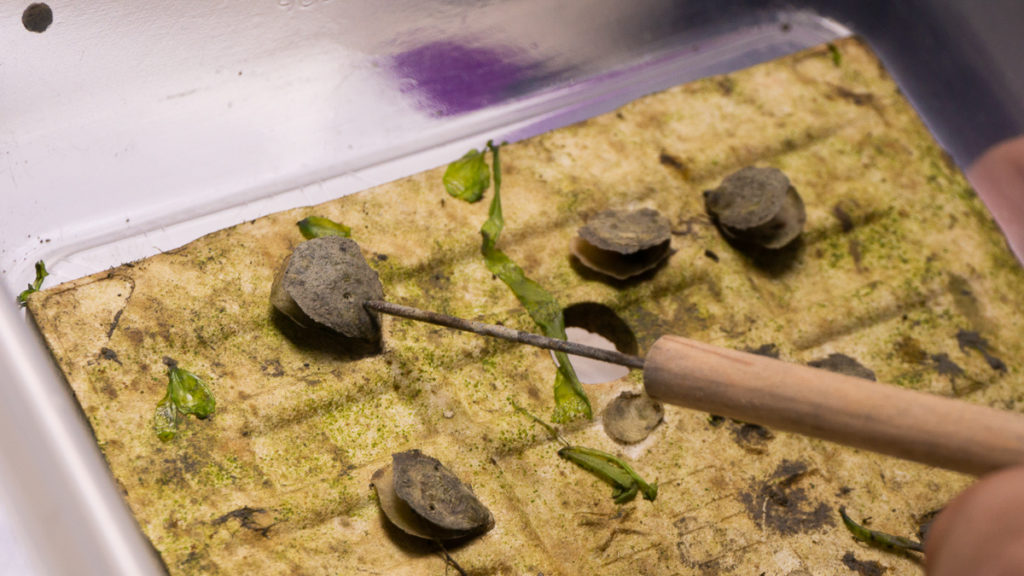by Philip Kiefer
In the messy world of science, real progress often happens when experiments don’t go as planned. It’s in these moments that scientists learn that the world doesn’t work like they expected. This year, two teaching fellows at the Smithsonian Environmental Research Center (SERC) had a taste of that during a summer project on oyster predation. Although the data they collected didn’t answer their questions about oysters, it did tell an unexpected story about the coastline. They’re bringing that knowledge back to their classrooms, to show students that science isn’t just about collecting facts, but about how to creatively interrogate the natural world.
This summer, SERC’s West Coast lab hosted two fellows from California’s STEM Teacher and Researcher (STAR) program. The fellowship supports STEM teachers who want to actively pursue science research during the summer in order to bring that experience back to their classrooms.

Evie Borchard and Jason Thomas, teacher-researchers at SERC, stand in front of prime oyster habitat in the San Francisco Bay. (Philip Kiefer/SERC)
“We want to give teachers the opportunity to do research that they can share with their students,” said Erin Blackwood, an education and outreach coordinator at San Francisco State University who organizes the STAR program locally. “At the same time, the program gives our scientists a new perspective on science education–they have to think about how they would teach their research to a high-school student.”
The pair who joined SERC, Evie Borchard and Jason Thomas, were both scientists before they became teachers. Thomas, who is beginning his second year as a chemistry teacher in Long Beach, originally wanted to go into medicine, but then realized that he could be more satisfied as a teacher. “I didn’t need to be a doctor!” he said, because he could pass along his knowledge to students.
Borchard began teaching in a juvenile detention center after graduating with a degree in biology. She loved the work of teaching, but was frustrated by the lack of resources. She decided to go to back to school, and is now in the second year of a master’s program. Her goal, she says, is to “allow students to become active in their learning. I want to be one of the people who research and develop ways in which [that] can be most effectively provided for students.”
Course Correction
Thomas and Borchard spent the summer working with SERC scientist Chela Zabin, who studies ecosystem restoration in the San Francisco Bay, with a focus on native oysters.
Olympia oysters were once prolific in the region, until overharvesting and other factors devastated them in the mid-1800s. Large-scale restoration efforts have been hampered by an introduced snail, the oyster drill. If you live life glued to a rock, even a snail can be a fearsome predator: The drill can sniff out nearby oysters and cut through their shells using a chainsaw-like tongue. On shorelines where the oyster drill is common, oysters are practically nonexistent, devoured by drills as soon as they settle.

The oyster drill, a type of predatory snail, is a voracious predator in the intertidal zone. (Philip Kiefer/SERC)
To investigate the predation, Thomas and Borchard set hard ceramic tiles out at three different tidal elevations—high, middle, and low, for simplicity’s sake—and recorded both how many oysters settled on them, and how many were eventually eaten. Some previous research suggested that oysters could survive on sections of the beach higher than oyster drills, giving them a narrow band of refuge from predators. The team wanted to see if that held true locally.

This juvenile oyster was killed and eaten by an oyster drill, which leaves a tell-tale circular hole in the oyster’s shell. (Philip Kiefer/SERC)
However, only a single oyster showed up for their experiments.
It’s hard to tell a story about oyster survival without any oysters, and so the teachers were forced to reexamine their experiment. Although their data didn’t say much about oysters, they found that they were seeing interesting patterns about another interesting creature: barnacles.
Barnacles are one of the oyster drills’ favorite foods. The teachers figured that if they could understand the story of barnacles, it might shed some light on the story of oysters. The barnacles tended to settle at the middle and lower elevations, in places that were underwater more often. But those same barnacles were also eaten much more often. Zabin is careful not to draw firm conclusions about what this says about oysters—it’s not actually possible to tell if the barnacles were eaten by drills, as the drills can scoop barnacles from their shells without a trace.
“We aren’t sure what caused the high mortality of barnacles on the [middle tiles], but these are the tiles that tend to have the most oyster drills at this site,” Zabin said. But the results support her previous observations: Both oysters and barnacles seem vulnerable to predators in the same part of the beach. From studying one animal, we can learn something about the other.
Science Research in the Classroom
This kind of problem solving is exactly what the two teachers hope to bring back to their students.
“I’m using this experience to give kids a more realistic view of science,” Thomas says. He wants to expose his students to the dead ends and false starts of the research process, to teach them that science is really a creative process of asking and answering questions.
He says that he wants his lessons to be structured around students’ questions. One of his favorite experiments involved figuring out the chemical composition of Flaming Hot Cheetos.
“Everything can be science,” he said. “If you encounter something and you’re curious about it, how do you know what to do next?”
That’s exactly the point of the STAR program, said Blackwood. “We want to reshape the field of science education.” STAR is designed to support the Next Generation Science Standards, which involve not just teaching students the core ideas of modern science–kinematics, evolutionary biology, and so on–but to introduce them to the practice of science.
Teaching science shouldn’t be just about teaching kids scientific facts, Thomas said. “It’s about teaching them how to think like a scientist.”

